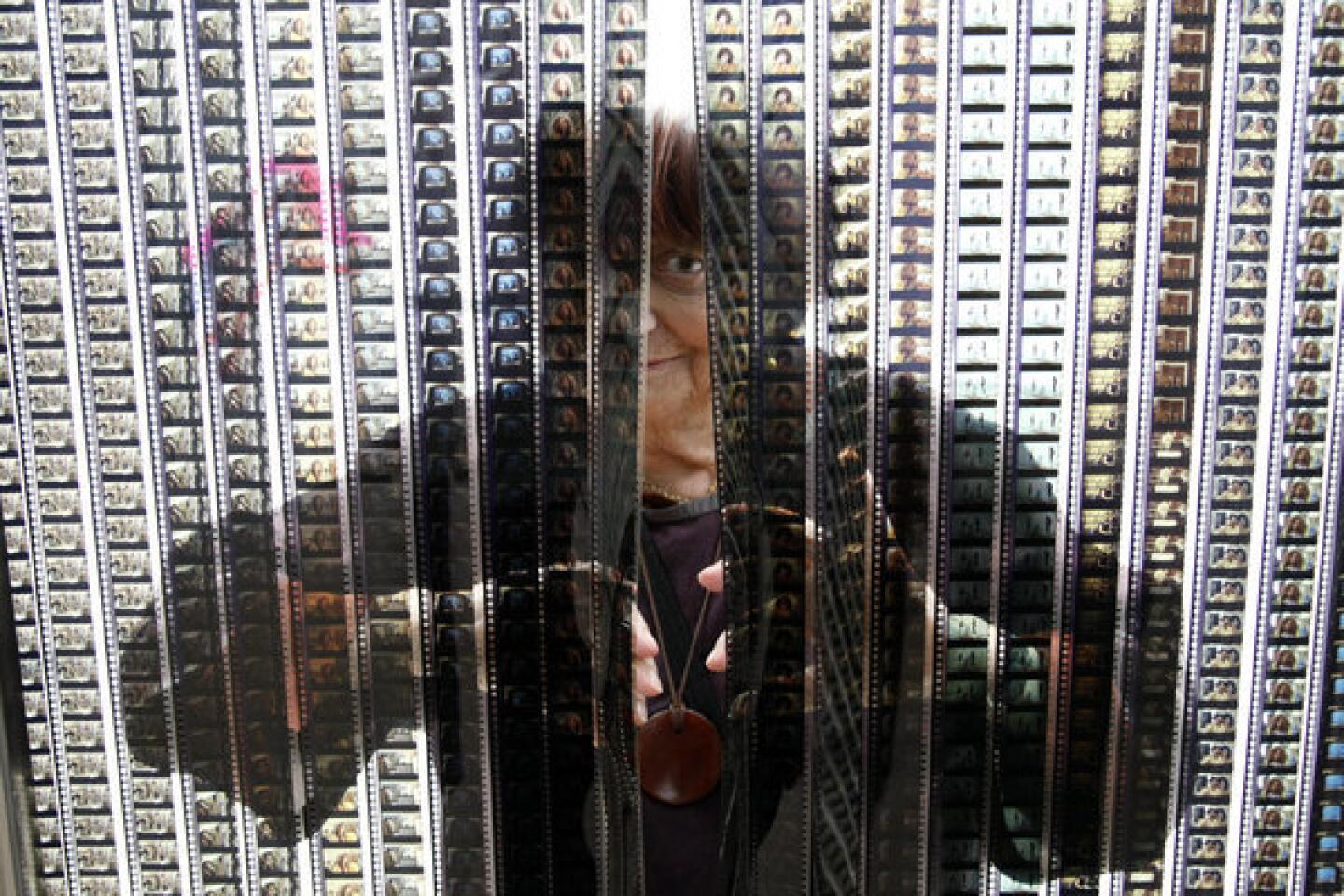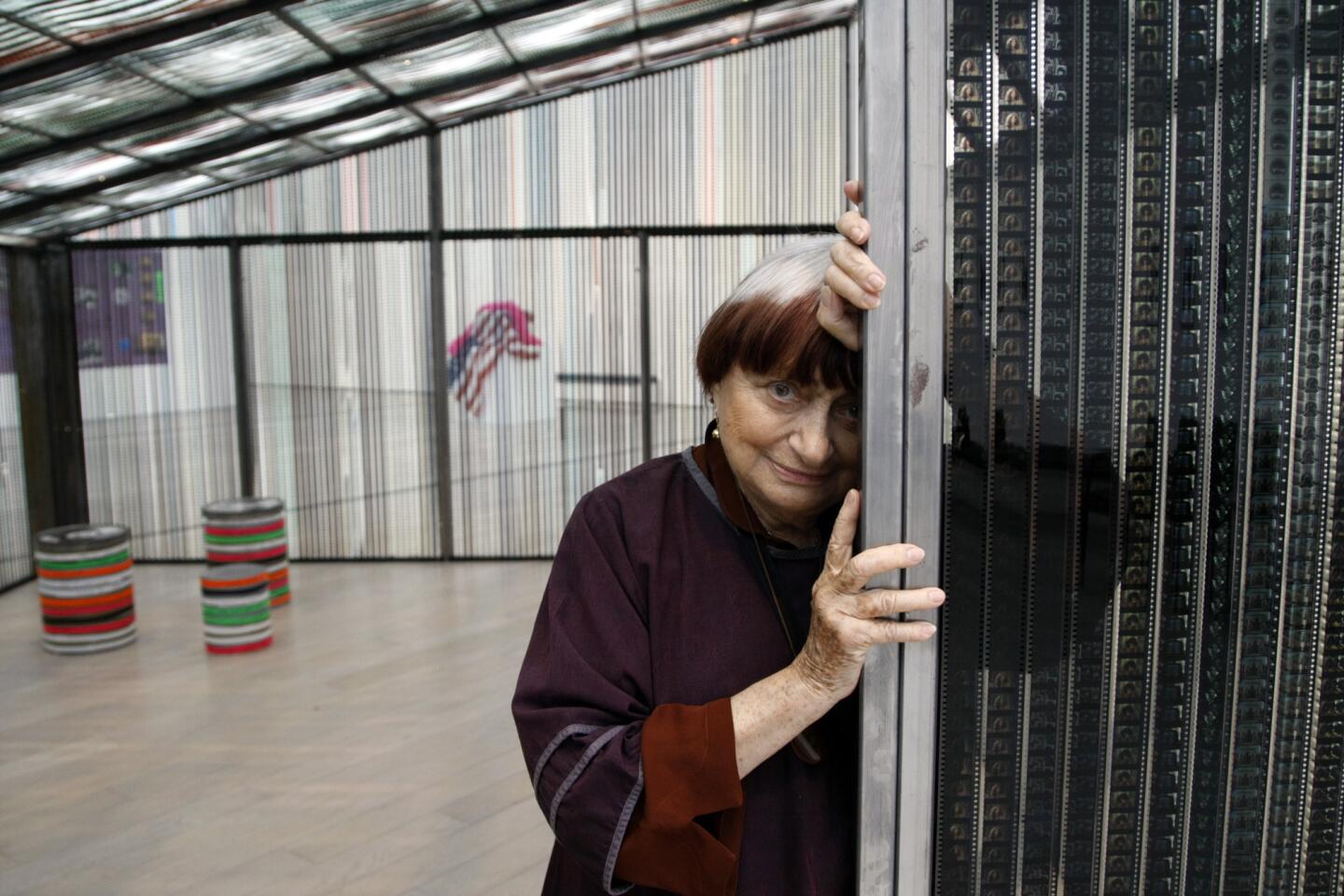Film auteur Agnes Varda marks her California return with artful glee
- Share via
“Let’s sit inside,” Agnès Varda proposed. “We’ll have a kick.”
Lifting her cane, the mother of French New Wave cinema began shuffling across the floor of the gallery at the Broad Contemporary Museum at LACMA.
Her destination, a few paces away, was her art installation “My Shack of Cinema,” a one-story walk-in structure with walls and roof made of 35-millimeter film strips from “Lions Love (...and Lies),” Varda’s 1969 classic about an easygoing L.A. ménage à trois, the murder of Robert F. Kennedy and the demise of Old Hollywood. For seats, there were stacks of film canisters and a couple of armchairs, which the Los Angeles County Museum of Art added “to be nice to me,” Varda said, plumping herself down in one.
CHEAT SHEET: Fall arts preview
“This is very strange,” the 85-year-old auteur continued, surveying her makeshift celluloid surroundings at LACMA’s new exhibition, “Agnès Varda in Californialand.” “I have never been in the middle, of the center, of film. So you have the feeling that the time has been spread out.
“This is inside the work, inside the whale again.”
Like much of her artistic output, Varda’s shack is a fanciful, multi-layered metaphor. It is equal parts artist’s studio, architectural canvas for experimental living, echo chamber of memory in present tense and children’s treasure chest. It is a love shack dedicated to her passion for filmmaking and life.
“When we are kids, we need a shack,” she had told a media gathering the night before. “A child needs to have something that is his little corner, his little nest, his own shack. But the more we grow older, we have different ways of approaching the theme. But it’s a theme that a lot of artists have approached, because it’s like in the big world it’s a little place.”
Varda has come to Los Angeles this fall not only for the LACMA exhibition but to serve as guest artistic director of the AFI Fest, which began Thursday. The festival features photos from her influential 1962 film “Cleo from 5 to 7,” which it’s also screening, along with her “Documenteur” (1981) and four films that have inspired Varda during her six-decade career: Robert Bresson’s “Pickpocket”; John Cassavetes’ “A Woman Under the Influence”; Rainer Werner Fassbinder’s “The Marriage of Maria Braun”; and Martin Scorsese’s “After Hours.”
Varda has been enjoying the tributes and attention, which she repays with patience and good humor. Chicly attired at the LACMA interview in a flowing purple dress, she wore a button that read “I Can’t Remember Your Name” and a new version of her familiar pageboy haircut, auburn at the lower reaches and white on top, as if someone had dipped her in powdered sugar, lending her the appearance of a kind of punk Joan of Arc.
“I’m a big bear, and they give me honey,” she said. But, she allowed, awards and accolades aren’t really the point. “I don’t want to be honored, I wanted to be loved — my films.”
But not her personally?
“Yes, I also want love. Who doesn’t want love, c’mon!”
Encompassing photography, sculptural installations and film screenings, LACMA’s exhibition traces two periods, first the late 1960s, then the early 1980s, that Varda spent living and working in California with her husband, the director Jacques Demy, and the couple’s two children.
Like the shack, California became a creative universe unto itself for Varda. During her time here, she made five films that capture the Golden State in all its orange-blossom and carbon-monoxide allure during an era of breakneck transformation. Stretching and collapsing the boundaries between fiction and documentary, her films were as self-consciously aware and stylized as her image-obsessed subjects.
ART: Can you guess the high price?
“She’s always interested in the relationship between art and life,” said Bernardo Rondeau, LACMA assistant curator of film. “Los Angeles is a city where those two things can kind of coexist in a way that you can’t in other places.”
Although Demy had been invited to Hollywood to make studio films, capitalizing on his 1964 international hit musical “The Umbrellas of Cherbourg,” Varda and her husband were most captivated by America’s blooming countercultures and then-marginal communities. “I remember going directly to Watts, East L.A. I didn’t run to see only Bel Air,” she said.
They were equally mesmerized by the sheer novelty and profusion of America’s consumerist affluence. “We were discovering the cheesecake and the convertible cars that open like this — bru-uhhr! So we had fun when we came, me and Jacques Demy, in ’67.”
The individual and collective pursuit of freedom — political, sexual, artistic — and the rewards and discontents of actually attaining it, is one unifying theme of Varda’s California output. Whether her subject was Oakland revolutionaries (“Black Panthers”), Sausalito hippie artists (“Uncle Yanco”), an expat single mother in Venice (“Documenteur, an Emotion Picture”) or East L.A. street painters (“Mur Murs”), Varda turned an empathetic and prescient gaze on the state’s hothouse social experiments.
But in contrast with other ‘60s films that used L.A. and California as an abstracted backdrop, her works are insistently street-level and human-scale.
“She goes and she engages with people,” Rondeau said. “She doesn’t see them at a remove, she lets them speak for themselves.”
PHOTOS: Arts and culture in pictures by The Times
Those qualities coalesced in “Lions Love,” perhaps the most emblematic of Varda’s California films. Its trio, composed of Warhol superstar Viva and the authors of “Hair,” James Rado and Gerome Ragni, are whimsical but savvy flower children living in a rented hilltop home, comporting themselves with the goofy pluck and verve of characters in a Noël Coward play.
Struggling to grow up in a land of ephemeral pleasures and childlike gratifications, the threesome is rocked by two seismic spasms: Robert Kennedy’s assassination, and the arrival of an avant-garde New York filmmaker (and Varda stand-in) played by Shirley Clarke, who’s been hired to make a studio picture.
In some ways, the California on view in Varda’s films has moved into the past. Returning to L.A. this fall, she said, she notices the men are clean-cut, not shaggy.
“The richer are richer, the poor are poorer, which is the same all over the world.” This time, too, Varda is without Demy, who died of AIDS in 1990.
In the wide-open cinematic spaces of Vardaland, la liberté is more than just another word for nothing left to lose. And, she insists, she has never felt freer in her life.
“The more old you are, the more you feel free. I don’t have to justify myself. They don’t like it, fine.”
Yet as the interview wrapped up, and she exited her love shack, Varda leaned toward a reporter, thinking once more of her late husband.
GRAPHIC: Highest-earning art executives | Highest-earning conductors
“It was taken from me,” she said in a voice she had not used all morning. “I wanted to get old together.”
The moment passed.
Already Varda was on to her next interview, ever ready for the new encounter, still comfortably ensconced inside the house of cinema, still getting her kicks.
------------------------------
Agnès Varda at AFI Fest
Where and when: “Cleo From 5 to 7,” 3 p.m. Sat., Egyptian Theatre; “Documenteur,” 4:30 p.m. Sun., Chinese 5.
Tickets: https://afifest.afi.com/sections
Agnès Varda in Californialand
Where: Los Angeles County Museum of Art, 5905 Wilshire Blvd.
When: Through June 22. Closed Wednesday.
Information: (323) 857-6000; https://www.lacma.org
More to Read
The biggest entertainment stories
Get our big stories about Hollywood, film, television, music, arts, culture and more right in your inbox as soon as they publish.
You may occasionally receive promotional content from the Los Angeles Times.













